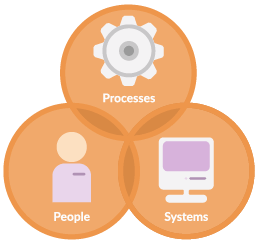Planning: first organize, then automate.
We regularly see that project-based service providers enthusiastically start a trial version of Timewax, only to find that they’re not properly prepared. Their organization is not yet in place. Obviously, that needs to be sorted out first before starting to use a software planning tool. In this blog, we will discuss the 3 ingredients for good organization in terms of planning.
The ingredients are: processes, people and systems. However, these ingredients cannot be considered as equal, simply because processes have a significant influence on the required people and systems. After all, depending on how you organize the planning process, it will not only make certain demands of the qualifications of planners and project managers, but also on the required functionality of the planning system.
When selecting a software planning tool, you do not necessarily have to consider redesigning the planning process or job vacancies, but it is advisable to keep it in mind. The organization may have grown and that may require a different approach, both in terms of processes and people. Consider this first before looking for the solution to your problem in a planning tool.

1. Designing a planning process
If you do what you always did, you get what you always got
Organizational structure
The organizational structure determines to a large extent how processes work and which people play a role and where. Are you working with one department that carries out all the projects? Do you have a service or support team that handles all the small jobs? Or do you need to work with a matrix organization with functional teams of, for example, designers, engineers and developers, where individual employees are involved in multiple projects?
Stop the tug-of-war over employees by choosing a suitable organizational system for the various projects and jobs. This largely determines how the planning process should be designed. It is therefore good to review the organizational structure. Is the current structure still appropriate and effective?
Planning process
Next, you should look at how you are going to specifically develop the planning process. There are 4 stages of resource planning, that are closely related to the size of the organization. In other words, a start-up may not even need a process. In a slightly larger organization with, for example, 3 project managers, the project managers will plan everything. With more projects and project managers, you will centralize the planning and create a separate function for this, such as a planner or resource manager.
It is important to make timely adjustments to the process. This way, you can avoid a situation where, for example, in the absence of central planning, all project managers start expropriating the (best) employees within the company. On the other hand, you also have to prevent optimizing your planning too early by introducing strict procedures and systems. This may not suit a small organization and will thus limit its effectiveness.
Measuring objectives
A process for planning your projects is only effective if you constantly improve it. The starting point for improvement is setting a goal. For example, an increase in the number of billable hours per person, or a reduction in the number of days exceeding the deadline for the delivery of projects.
These objectives impose direct demands on a planning system. The system must also be able to register the actual hours in addition to the planned hours in order to determine the billable hours. In this example, the system must also be able to ascertain the planned deadlines and the actual delivery times of these projects.
2. Employing the right people
A fool with a tool is still a fool
Planning skills
It’s true that people do make a company, but only the right people with the right (planning) skills. The successful execution of the planning process will stand or fall on this fact. Take a critical look at the employees who are currently involved, such as planners, resource managers and project managers. Do they have the necessary skills to plan effectively?
In the article Belbin team role of a planner, a correlation is made into essential planning skills and what kind of profile these people should ideally have. On the basis of this, you can correctly assess whether the current employees have what it takes, or whether they need to go through a development process in order to be able to properly fulfil their role in planning.
Awareness of each other’s drives
After the project managers and planners with the right skills have been appointed, it is also a good idea to pay attention to their level of cooperation. The drives of planners vs. project managers can differ considerably, which means they may be at odds with each other. Planners like to stick to the agreed procedures, while project managers will always try to get the best results for their project, regardless of the rules.
These opposite drives can frustrate the planning process considerably. Management therefore should see to it that both sides adopt an attitude to complement each other, instead of competing with each other. By understanding each other’s drives and helping each other, a much smoother, and therefore more effective, planning process is created.
Affinity with software
This aspect is often overlooked, but in our experience, we regularly deal with people who cannot handle software properly. They lack affinity with the software because, for example, they may be a little older, or because they simply don’t work with computers very often. These people also often find it annoying or frustrating that they cannot grasp the software as quickly as others.
This of course carries the risk that they’ll make mistakes in the planning system and require a relatively large amount of time to carry out tasks. We’ve all come across a colleague who is not very fluent with computer systems. It’s wise to invest in training programs for these people, because avoiding errors and teaching them to work faster and more efficiently will pay handsome dividends.
3. Choosing an appropriate planning system
Structured software selection
It is very tempting to search for planning software on the internet and try out all kinds of trial versions, but this can be a major pitfall. Each supplier presents its software differently and each software package has different, and often not comparable, features. So you click your way through the different trials until you’re unable to distinguish one software application from the another.
Selecting planning software requires following 3 essential steps. First, you start by making a blueprint. This is the foundation of how the planning process will be organized. Then you set up 20 knock-out criteria, which the software absolutely must meet. Only in the final stage, will you start a trial version of the 3 or so remaining contenders, to try out a use case that you have prepared in advance.
Implementation
Once you have chosen the software, the next step is the implementation. The implementation will make or break the success of a planning system, so make sure that the right people are involved and that you have identified the various implementation issues beforehand.
Are you going to implement the system centralized or decentralized? With a decentralized implementation, each department has a fair amount of freedom regarding how they use it, unlike with a centralized implementation. Are you going to implement the system big bang or phased? In other words, will all departments go live at once, or one by one? And will you use a process or system driven implementation? Is your process sacred, or are you prepared to tweak your process here and there in line with the software?
Keep optimizing
Just as you continue to tinker with the planning process, you should also continuously look at how you can better use the planning system. Timewax often notices that customers stop looking at the software once it’s running. They often start with a minimal set of features, with the intention of expanding the usage later. Unfortunately, later never comes because of other priorities.
Technology is advancing rapidly and software suppliers are constantly coming up with new features. Often these features are also available free of charge. Make the best use of all the resources at your disposal and keep an eye on new releases.
Conclusion
Do not be too hasty to look to software for the solution to your planning problems. Remember, organize first, then automate. In this blog we discussed 3 ingredients: processes, people and systems. First make sure that you have the processes and people in place (organizing). A good process with the right people can indeed be done without the help of a planning tool. It just takes more time – and it’s not as efficient.
On the other hand, using a software planning tool without a well-organized process in place and/or the right people with the right planning skills, is doomed to fail. So, make sure you first get the basics right, then automate it with the right planning tool to make it even more efficient.





